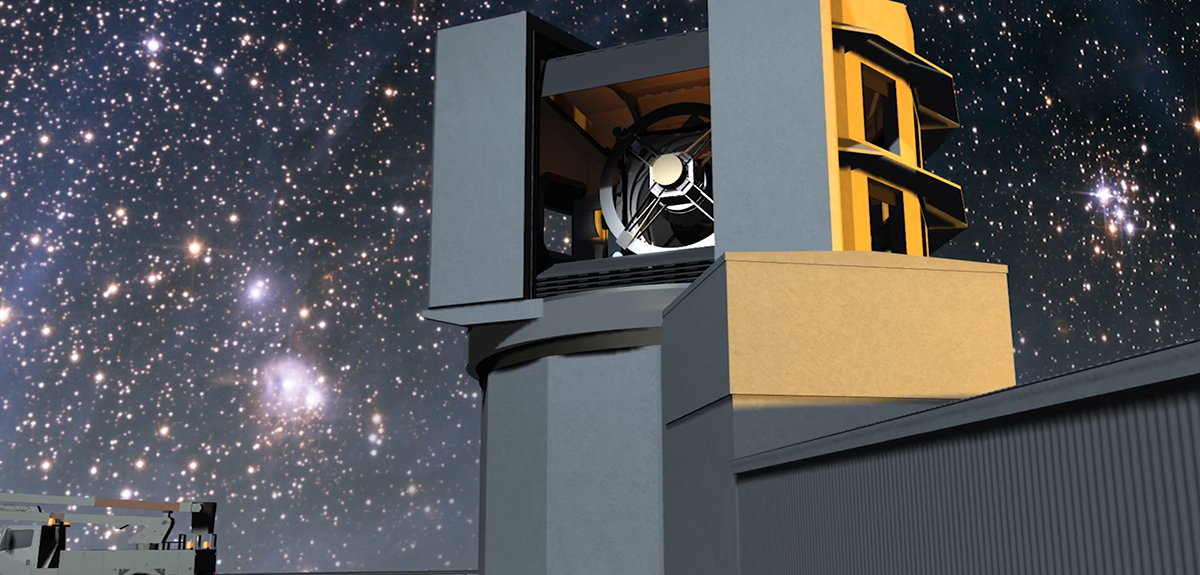You are here
This hefty piece of metalwork has kept researchers and engineers busy for the last ten years. Welcome to a research lab at the University of Jussieu in Paris. These scientists are making the final adjustments to a crucial component of what is to become the largest camera ever built. It will be used to film a particularly ambitious movie: one that will tell the story of our Universe.
The camera will be mounted on the LSST – the Large Synoptic Survey Telescope – an instrument at the center of a massive leap forward for astronomy. Currently in construction in Chile, the LSST is set to photograph the night sky for ten years, creating a film of our universe in 3D.
PIERRE ANTILOGUS
The Universe is anything but static. There are stars dying, galaxies forming, and other galaxies with incredibly active cores.
The purpose of the LSST is to complete our cartography of the universe with the sharpest lenses and understand how the Universe formed. How it evolved…
Thanks to this camera, the LSST will be able, in a single frame, to capture a surface area equivalent to 40 times that of the Moon. 800 shots will be taken every night, enough to complete a map of the sky in three days.
It will also be possible to study the dynamic movement of our universe, exploring the biggest questions in astronomy today.
PIERRE ANTILOGUS
By studying the evolution of the universe, we’ll measure the properties of its components. In particular dark matter and dark energy. These are the drivers that regulate the evolution of the universe over time.
Dark matter and dark energy are two elements that allow researchers to describe the evolution of the universe since its birth. Even though we suspect they constitute more than 95% of the cosmos, they remain incredibly mysterious. The LSST’s cosmic film will enable a better study of their effects.
But that’s not everything. From its conception, the LSST was also built to track “Near Earth Objects,” asteroids at risk of colliding with our planet.
PIERRE ANTILOGUS
The LSST is effectively capable of identifying Potentially Hazardous Objects at a relatively small size. It will give us advance warning of all Near Earth Objects big enough to have a significant impact on life on Earth.
In order to fulfill all of these objectives, the LSST’s camera will be fitted with a 3.2Gigapixel sensor, along with a variety of colored filters. These filters are essential for measuring the color of different celestial objects, which reveals their distance from Earth.
These are the French scientists who designed the filter exchange system, a central element of the camera.
PIERRE ANTILOGUS
The faster the galaxies are moving away from us, the redder they appear. So if we're able to measure their color and then see how much energy they're emitting in a blue filter as compared to a red one, we can deduce their distance.
PIERRE KARST
As we’re working on the largest camera in the world, obviously the filters have to be the biggest as well. They weigh between 26 and 38 kilogrammes. The requirements for the filter changer is to move these massive filters and reposition them to a precision of within a tenth of a millimeter.
These filters must be able to change rapidly and automatically. They need to capture the best possible images without missing a celestial beat.
The filter changer was conceived and created by five different French laboratories. One of the most important components is a carrousel which can hold five of them simultaneously.
It can change filters in under two minutes, which allows the maximum number of images over the life of the project.
Vast amounts of information are produced and must be processed and stored. Every night the telescope generates 20 terabytes of data. With this nightly volume, by the end of the project, dozens of petabytes - or millions of gigabytes - will have been produced – all of which will be stored in Lyon, France.
PIERRE ANTILOGUS
We're talking in petabytes or even in exabytes if we are considering the amount of data produced during the whole life of the project. We have no experience of such a data flow in the astronomy world today. There is now a very big effort with the LSST project to develop the computing techniques to handle the data in an efficient way.
It is one thing to say "Hey, check out my petabytes worth of hard drives?" You have to be able to read it. It’s a very difficult thing to provide an efficient method to access such volumes of data. And the LSST is on the forefront of such technology.
After assembling all the elements of the future filter exchange system, the scientists are preparing the final tests to assure it functions properly. They’ll ship it on to the United States, where it will be integrated with the camera before continuing down the road to its final destination in Chile. Then they can begin filming what will certainly be the greatest movie in the world – one of cosmic proportions.
A Camera of Cosmic Proportions
The LSST, or Large Synoptic Survey Telescope is about to conduct a 10-year survey of the sky. It will deliver a 500 petabyte set of images and data products that will address some of the most pressing questions about the structure and evolution of the Universe and the objects in it.
Laboratoire Physique Nucléaire et Hautes Énergies (LPNHE)
CNRS / Sorbonne Université / Université de Paris
Pierre Karst (CNRS)
Centre de Physique des Particules de Marseille (CPPM)
CNRS / Université Aix-Marseille





